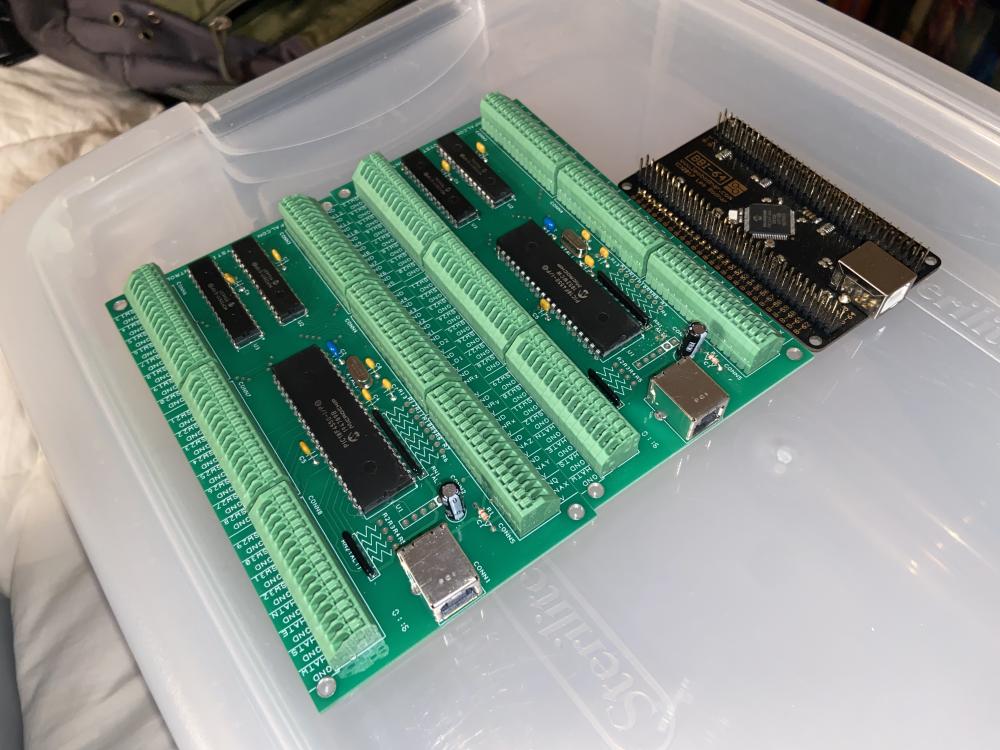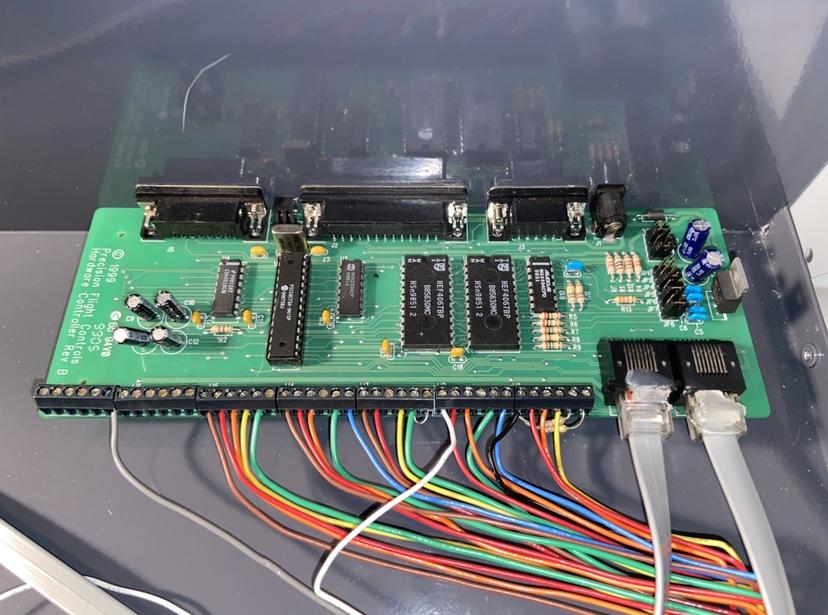
Knox1423
Members-
Posts
8 -
Joined
-
Last visited
Content Type
Profiles
Forums
Events
Gallery
Downloads
Everything posted by Knox1423
-
Hey Alexandr. I got your message and thought I'd reply here rather than DM to convey the info to others interested. After a week or so of trial and error, I wasn't able to satisfy the equipment communication with the computer software, which is what led me to try a hail Mary with the USB controller board. As I said, it's definitely not perfect, but converting the input from COM port to USB was nice despite it's flaws. I'll attach a picture below of the boards.
-
I just wanted to follow-up on this problem. I essentially never found a solution between days of troubleshooting, contacting PFC for support, and trying all the helpful advise given here. I can't remember if I mentioned this, but there were (2) generic USB gamepad circuit boards included with the flight console (I assume the previous owner planned a future conversion), and in an attempt to get something to work, I resorted to unplugging every connection on the original board and reconnecting onto the USB board. To my surprise, it crossed-over very well, and just took some trial-and-error to get most of it working. Some of the buttons and switches don't work exactly as expected, but I think most of that is due to a lack of axis/slider inputs on the board itself. I was able to get everything working on the console besides the engine switches, flaps switch, and cowl flaps switch. At the moment I still have no rudder control, but will be working through a solution on that later, since I'm pretty troubleshooted-out. It's recognized by MSFS under the circuit board's name and acts as a standard USB controller. I'm not entirely happy with the current setup, as I would've liked to use the original hardware and all the features on the console, but having 90% of the control and standard USB is a satisfactory alternative. As I stated before, this obviously isn't much of a 'solution', since it involves a complete re-wire, but it helped in my situation. Thank you everyone for being so helpful and patient as I've worked through this project.
-
That was in reference to the guts of the flight console. Under the casing of the console, the throttle and yoke inputs connect to the main board via an Ethernet plug. See the picture attached: I acquired a new Serial port card for my computer, got it connected and drivers applied, and it recognized the COM ports as well. I started up MSFS with FSUIPC, started a flight with a twin-prop plane, went through the hardware check (again, yoke and throttles recognized and 'okay'd, but rudder pedals not recognized), and experienced the same issue under the Flight Controls tab where the yoke is tested. I'm concerned it's a hardware issue, because out of curiosity I just unplugged the yoke and throttle from the main board and was still receiving the ghost input on the Flight Controls configurator. Not being well-versed in bread/circuit boards, I'm honestly not sure what to do about it myself. My next thought would be to find someone who's (at least somewhat) familiar with it and see if they can help troubleshoot.
-
Hi Pierre, I really appreciate all the information you've provided! I'll be trying the setup with a Serial port card on my desktop later today as well as all the other tips provided and will advise if I get any further at that point.
-
It was set to 9600, and I read that's where it should be. I just remember coming across a note where there's a certain type of PFC module that requires 19200, so I tried that, but defaulted back to 9600 since it didn't change anything. This is a great lead. I'll go ahead and order a serial ports card for my computer to give that a try and see what I come up with. I'm not at home at the moment but will double-check that I have the correct files later. During my testing, I tried a number of different planes, just in case. I tried a single-prop, double-prop, and twin-engine jet. I have the same throttle quadrant shown in the picture you attached - 6 levers, 2/2/2, same colors. I really appreciate the advice, and will update when I get further. Thank you!
-
I reached out their way before I had all the cabling to confirm the power supply would be sufficient and provided some basic information about setup (assigning proper COM ports noting that for the applicable software). I reached back out in regards to this issue and have not heard back yet. They made a point in their original email though that they really don't support the older hardware anymore, so I'm honestly not holding my breath they're going to be much more help, even though I agree it seems like a hardware issue. At this point I'm at a standstill unless PFC ends up providing more clarity or I luck into the solution by trial-and-error. I appreciate both your help @Pete Dowson and @John Dowson and will let you know if I hear back or find a solution.
-
John, thank you for moving it to the appropriate location. Upon your note about the axes, I created a new preset in-game that removed all axes assigned. After that, I navigated to a fresh plane, and was still encountering the 'ghost' input issues. The cable I purchased connects to the DB9 port on the console, and USB 2.0 to the computer. On the computer under Device Manager, the input shows up under the COM-ports drop down menu, and is assigned to COM7, which I selected when the hardware checker popped up upon launching MSFS, after which it checked and gave me the okay for the yoke and throttle quadrant. I didn't realize it until you noted, but I had BOTH HID and COM files in the FSUIPC folder, so I moved the HID files out. I uninstalled and reinstalled FSUIPC7 just in case, added the COM DLL files back in, launched MSFS, got the 'okay' for the same hardware, but was still receiving the same 'ghost' inputs without my own touch. I've seen notes throughout the documentation I've read (I tried to read every possible doc on the software before sending in the request on the forum) that there are some niche issues where the hardware requires 19200 bit speed rather than the standard 9600, and have tried changing that on the port settings (the Speed:xxxxx setting was not shown on the DLL file, so I assumed I could change it in Device Manager), but still experienced the same issues. I attempted to use the PFC Hardware Calibration and Test GUI, but unless I'm missing something, nothing showed up on there and gave me no indication it recognized applicable hardware. I assumed that might've been maybe the program was designed for the USB/HID model of the console rather than the COM model. I'm determined to get this hardware to work, and maybe the solution is just something simple that I never thought of. My next thought was maybe trying another cable that connects the console to the computer, but it seems to connect to the PC fine and recognized without an issue; I'm not sure if that could be a factor or not. EDIT -- Here are the links to the cables I purchased for reference: USB to DB9, https://www.amazon.com/gp/product/B0758B6MK6/ref=ppx_yo_dt_b_asin_title_o00_s00?ie=UTF8&psc=1 DB15 (male) to DB15 (male), https://www.amazon.com/gp/product/B00O07653K/ref=ppx_yo_dt_b_asin_title_o00_s01?ie=UTF8&psc=1 Power Adapter, https://www.amazon.com/gp/product/B01GEA8PQA/ref=ppx_yo_dt_b_asin_title_o00_s01?ie=UTF8&psc=1
-
Good evening! I apologize if this is not the correct place for this type of troubleshooting question, but I'm hoping someone can help provide clarity with my situation. I will also note that I'm very new to this type of hardware and community. I acquired a PFC Cirrus II P.C.A.T.D. flight control console and rudder controls a few days ago and have been attempting to get it up and running. It's a model that was manufactured somewhere in the late 90's or early 00's, but I'm not exactly sure when. The only ports on the rear are serial COM ports - one for UCI (computer), rudder controls, and avionics. It lacked the original power adapter and serial cables for use. I ordered a new power adapter (confirmed by the manufacturer PFC to work), as well as a DB15 cable for the rudder controls and DB9 to USB-A cable to connect to my computer. I'm using a fairly new Windows 10 computer and wanted to use this control console with MSFS (2020). I installed FSUIPC and the PFC DLL files for compatibility and got the program up and running with MSFS. Once the game opened, it launched the hardware checker and confirmed everything on the console itself was good, but noted it could not detect the rudder controls (they were already plugged up to the console). This was fine at the moment as I just wanted to test out the yoke and throttle controls first to make sure those were working. I navigated over to FSUIPC, then to the PFC Add-On. I went to the Flight Controls tab for configuration, and noticed the Aileron input was changing without me moving the yoke. When I checked the throttle controls, two of them were jumping between inputs as well. I went through every calibration tab, enabled the appropriate column for which I had control (e.g. yoke, throttle, cowl flaps, etc.) and tried testing/calibrating. None of them seemed to work though; the only input being shown was the random input number changes that wasn't me. So far I've checked the cable connections, tried a similar but different power source, swapped the Ethernet yoke/quadrant connections on the internal board (in case they were inserted reversed, played around with the COM port settings on Windows 10 Device Manager, and a handful of other things that aren't coming to mind at the moment. I'm consider myself fairly technically savvy, but the combination of older hardware and layers of applications for compatibility is starting to go over my head as I've tried most solutions I would've believe to work. I can provide any additional information if needed, and have screenshot of the tabs where the inputs are changing, but the forum uploader noted they were too big to add. Any assistance would be very much appreciated. Thank you!

